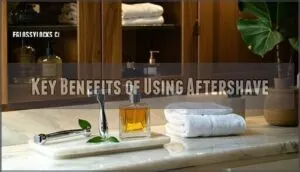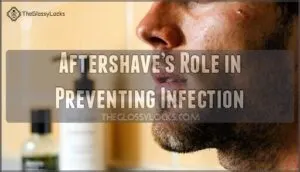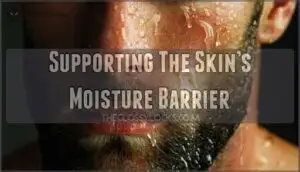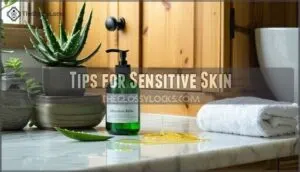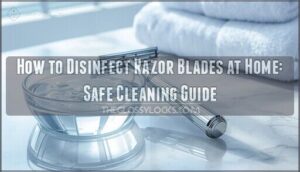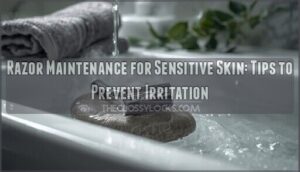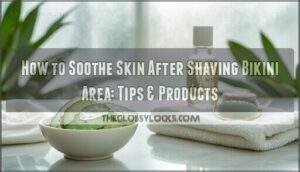This site is supported by our readers. We may earn a commission, at no cost to you, if you purchase through links.
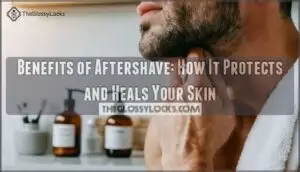 The benefits of aftershave application go beyond just smelling fresh—it’s your skin’s protective shield after shaving. Aftershave disinfects micro-cuts with alcohol and antimicrobial ingredients like tea tree oil, closing pores and blocking bacteria before they cause trouble.
The benefits of aftershave application go beyond just smelling fresh—it’s your skin’s protective shield after shaving. Aftershave disinfects micro-cuts with alcohol and antimicrobial ingredients like tea tree oil, closing pores and blocking bacteria before they cause trouble.
Soothing agents like aloe vera and witch hazel work wonders here—studies show they can cut irritation by nearly half, taking the sting out of redness and razor burn.
Moisturizers like glycerin, shea butter, and vitamin E jump in to lock hydration back into your skin, so you’re not left with that tight, scratchy feeling that has you clawing at your face.
Apply a small amount to damp skin using gentle circular motions—this helps the good stuff sink in where it counts.
Getting the most from your aftershave isn’t rocket science, but there’s definitely a right way to do it.
Table Of Contents
- Key Takeaways
- What is Aftershave and How Does It Work?
- Key Benefits of Using Aftershave
- Aftershave’s Role in Preventing Infection
- How Aftershave Hydrates and Nourishes Skin
- Best Practices for Applying Aftershave
- Incorporating Aftershave Into Your Grooming Routine
- Frequently Asked Questions (FAQs)
- Conclusion
Key Takeaways
- Aftershave disinfects micro-cuts with alcohol and antimicrobial ingredients like tea tree oil, killing up to 99.9% of bacteria and blocking infection before it starts. – Soothing agents such as aloe vera and witch hazel reduce skin irritation by up to 43% and redness by about 35%, providing measurable relief from razor burn. – Moisturizing ingredients like glycerin, shea butter, and vitamin E restore your skin’s hydration and repair the moisture barrier that shaving damages. – Proper application on damp skin using gentle circular motions ensures ingredients penetrate effectively, maximizing protection and healing after every shave.
What is Aftershave and How Does It Work?
Aftershave isn’t just about smelling good—it’s a functional skincare product that helps your skin recover after shaving.
Let’s look at what’s inside these products and how they aid your skin’s health.
Common Aftershave Ingredients
Most aftershaves pack alcohol—usually ethanol at 40% to 70%—which works fast to disinfect your skin right after shaving.
Beyond that, you’ll spot ingredients like witch hazel, aloe vera, and tea tree oil doing double duty: calming irritation while keeping bacteria at bay.
Moisturizing agents such as glycerin, shea butter, and vitamin E oil help prevent dryness. However, fragrance allergens appear in up to 78% of products, and antimicrobial additives like salicylic acid target specific skin concerns.
Some aftershaves, like this antibacterial option, are designed specifically for sensitive skin.
How Aftershave Supports Skin Health
Aftershave does more than just smell good—it’s actually working hard to close your pores, fight off bacteria, and calm your skin down after you’ve put it through the wringer.
Here’s what’s really happening beneath the surface:
- Antiseptic properties disinfect micro-cuts, aiding skin healing and infection prevention
- Moisture level balance maintains ideal skin hydration through emollients
- Skin barrier assistance strengthens your protective layer during post-shave recovery
- Skin tissue regrowth accelerates as ingredients reduce skin irritation prevention
Key Benefits of Using Aftershave
Aftershave does more than just smell good—it’s designed to protect and repair your skin after every shave. Here’s how it helps your skin recover and stay healthy.
Reduces Skin Irritation and Redness
One of aftershave’s biggest advantages is inflammation reduction and redness prevention. Studies show that soothing ingredients like aloe vera can reduce skin irritation by up to 43%, while witch hazel decreases redness and swelling by about 35%.
For sensitive skin types, aftershave balms with allantoin cut visible redness by nearly 40% compared to using water alone. Aftershave also provides antiseptic and antibacterial benefits to prevent infection.
That’s why post-shave care matters—it directly aids skin healing and minimizes discomfort.
Heals Nicks and Razor Cuts
Beyond calming irritation, your aftershave also speeds up healing when nicks happen. Alcohol-based formulas kill over 99% of bacteria, giving antiseptic protection that cuts infection risk dramatically.
Witch hazel aftershaves reduce contamination by 87%, while ingredients like aloe vera create a moist environment that accelerates wound closure by 25%. Alum blocks stop bleeding in under two minutes and promote faster clotting.
This antiseptic application paired with hydration shortens healing time and minimizes scar formation—real postshave skin care that works.
Prevents Razor Burn and Ingrown Hairs
Razor burn and ingrown hairs don’t have to be the price you pay for a smooth shave—aftershave creates a protective layer that prevents both problems before they start. Moisturizing ingredients like aloe and shea butter reduce friction, while antiseptic properties keep pores clear and prevent inflammation.
This combination of hydration and infection prevention stops ingrown hairs from forming and minimizes razor burn causes before irritation sets in.
Aftershave’s Role in Preventing Infection
When you shave, you create tiny openings in your skin that leave you vulnerable to infection.
Shaving opens micro-cuts in your skin that bacteria can exploit before your body has time to seal them
That’s where aftershave comes in. It uses antiseptic ingredients to kill bacteria and help close those micro-cuts before they become a problem.
Disinfecting Properties
When you shave, tiny cuts and open pores create entry points for bacteria. Alcohol-based aftershaves contain 60–90% alcohol that kills up to 99.9% of skin microbes within one minute through antimicrobial action.
This immediate bacterial reduction prevents infection and skin irritation. Even non-alcohol formulas with antiseptic ingredients like fragrance compounds reduce bacteria by disrupting cell walls, offering effective microbe control.
Applying aftershave right after shaving maximizes its efficacy as a skin sanitizer, eliminating harmful bacteria before problems start.
Protection Against Bacteria and Dirt
After killing bacteria, aftershave creates a protective shield that keeps new microbes and environmental dirt from invading your freshly shaved skin. Alcohol-based aftershaves tighten pores through their astringent effect, minimizing openings where bacteria can enter.
This pore-minimizing action works alongside antiseptic ingredients that maintain microbial control for hours after application. By functioning as both skin sanitizers and dirt repellents, these antibacterial properties safeguard your skin health throughout the day, preventing skin irritation before it starts.
How Aftershave Hydrates and Nourishes Skin
Aftershave doesn’t just protect your skin—it also helps keep it soft and healthy.
Let’s look at how the right ingredients work to hydrate and nourish your skin after you shave.
Moisturizing Ingredients (Aloe, Shea Butter, Vitamin E)
Here’s the thing about post-shave care: killing germs isn’t enough. Your skin’s crying out for moisture after all that scraping. The best aftershaves pack three natural hydrators that actually work.
- Aloe vera delivers instant moisture (it’s 99% water) and calms redness by 33%
- Shea butter locks in hydration with fatty acids that prevent water loss
- Vitamin E repairs damaged skin and reduces sensitivity
- Combined formulas boost moisture levels by 66% in under one minute
- Clinical studies show 96% of users experience zero irritation
These ingredients work together in your skin care routine, providing aloe vera benefits, shea butter properties, and vitamin E effects that transform dry, irritated skin into smooth, comfortable tissue. That’s real skin hydration.
Supporting The Skin’s Moisture Barrier
Your skin’s moisture barrier is like a brick wall—when shaving damages it, water escapes and irritants flood in. Aftershave with humectant properties pulls moisture back into your skin, while natural oils repair barrier damage.
Quality moisturizers restore moisture balance within minutes, preventing skin irritation and maintaining proper skin hydration. This barrier repair keeps your skin care routine effective and your face comfortable all day.
Best Practices for Applying Aftershave
Applying aftershave the right way makes all the difference in protecting your skin after you shave. Here’s what you need to know about technique, amount, and handling sensitive skin.
Proper Application Techniques
Getting your aftershave technique right separates smooth, happy skin from that awful burning sensation nobody wants. Here’s how to nail your post-shave routine and keep irritation at bay:
- Rinse with cold water to close pores after shaving
- Pat your face damp—don’t dry completely for better absorption
- Use a small aftershave amount in your palm
- Apply with a gentle massage using circular motions across shaved areas
These application tips help aftershave ingredients work effectively in your post-shave routine.
How Much to Use and Where
Most people use too much aftershave or miss key areas, which can lead to wasted product or uneven protection.
Follow this aftershave application guide for proper skin coverage:
| Shave Area | Application Amount |
|---|---|
| Face and neck | Dime-sized amount |
| Legs | Quarter-sized per leg |
| Underarms | Pea-sized each side |
| Head/scalp | Nickel-sized |
Using the right aftershave dosage ensures moisturizing benefits reach every shaved area. The product quantity depends on skin coverage needs—aftershave ingredients work best when applied evenly across your shave area for complete skin irritation prevention.
Tips for Sensitive Skin
If you have sensitive skin, choosing the right aftershave formula matters more than getting the application amount perfect. Look for fragrance-free options that won’t trigger irritation and aid skin barrier repair during your skin care routine.
Your sensitive skin care checklist:
- Skip alcohol-based formulas – They strip moisture and cause stinging
- Choose aftershave balm – Provides deep moisturizing without harsh ingredients
- Look for soothing remedies – Aloe vera and chamomile calm redness
- Patch test first – Apply to a small area before full use
- Pair with gentle exfoliation – Prevents ingrown hairs without aggravating skin
Incorporating Aftershave Into Your Grooming Routine
Getting the most out of aftershave means knowing when and how to use it in your daily routine.
Here’s what you need to think about to make aftershave work for your skin.
When to Apply Aftershave
When you apply aftershave makes all the difference. Your skin’s like a sponge right after you shave—still damp and ready to soak up moisture.
Hit it with cool water first to calm things down and close those pores, then pat your face dry (rubbing’s a rookie move).
Now you’re set for application.
| Shaving Routine Step | Aftershave Timing | Skin Type Considerations |
|---|---|---|
| Pre-rinse | Wait 30 seconds | All skin types benefit |
| Post-shave care | Apply within 1 minute | Sensitive skin needs immediate soothing |
| Daily routine tips | Use after every shave | Oily skin may need less product |
Following proper aftershave timing as part of your skin care routine maximizes the benefits of aftershave and aids postshave skin care. How to apply aftershave correctly starts with understanding when your skin is most receptive—right after shave preparation ends.
Complementary Post-Shave Skincare Steps
Aftershave isn’t a one-and-done solution—it needs backup. Exfoliate twice a week to keep ingrown hairs at bay, then reach for a soothing serum when your skin needs extra moisture.
Skin toning balances pH levels postshave, while facial massage boosts circulation and product absorption.
For deeper care, try post-shave masks that deliver intense moisturizing benefits. Layer these skincare steps strategically—your skin care routine should build protection, not overwhelm it.
Choosing The Right Product for Your Needs
Your skin type assessment should drive your choice—alcohol-based aftershaves suit oily skin, while moisturizing balms work best for sensitive skin.
Check product ingredients carefully: aloe, shea butter, and vitamin E deliver hydration without irritation.
Consider fragrance options and texture preferences, but watch for allergy considerations.
Types of aftershave vary widely, so match formulations to your skincare routine’s specific needs for best results.
Frequently Asked Questions (FAQs)
Can aftershave replace daily facial moisturizer products?
While some aftershave balms offer moisturizing benefits, they usually can’t fully replace a dedicated facial moisturizer in your daily skincare routine.
Most aftershaves target post-shave concerns rather than providing the thorough skin hydration your face needs throughout the day.
Does aftershave work on electric razor irritation?
Yes, aftershave works well for electric razor irritation. Electric shavers can still cause friction and minor trauma to your skin, leading to redness and razor bumps.
Aftershave alternatives with soothing ingredients provide razor burn relief just like they do after wet shaving.
Are alcohol-free aftershaves better for aging skin?
Alcohol-free aftershaves work better for aging skin because they don’t strip away natural oils. As skin matures, it produces less moisture on its own.
Gentle formulas with natural ingredients like aloe and vitamin E help moisturize without irritation, making them ideal for sensitive skin that needs extra care.
Can aftershave help with post-shave acne breakouts?
Think of it like this: shaving creates tiny openings in your skin, which can trap bacteria and trigger breakouts.
Aftershave with antimicrobial ingredients like tea tree oil or witch hazel helps keep pores clean and reduces inflammation. This creates a cleaner environment for your skin to heal, which means fewer acne flare-ups after you shave.
Should aftershave be applied morning or night?
You should apply aftershave right after you shave, whether that’s your Morning Application or part of your Nighttime Routine.
Your shaving routine timing matters less than consistency—aftershave works best on damp skin to moisturize and calm irritation immediately after each shave.
Conclusion
After you shave, your skin’s in a vulnerable spot. Tiny nicks and open pores need protection from bacteria, and irritation’s just waiting to flare up.
That’s where aftershave comes in—it’s not about smelling good (though that’s a bonus). It disinfects cuts, calms inflammation, and restores moisture all at once.
Apply it on damp skin right after shaving, pick a formula that matches your skin type, and you’ll see fewer bumps and smoother results.
Skip it, and you’re gambling with razor burn and breakouts. Make it part of your routine—your face will thank you.
- https://www.forbes.com/sites/josephdeacetis/2021/12/22/the-best-aftershaves-for-men-the-ultimate-guide/
- https://pmc.ncbi.nlm.nih.gov/articles/PMC10818121/
- https://pinkwoolf.com/blogs/news/banishing-post-shave-itch-discover-the-causes-and-ultimate-remedies
- https://my.clevelandclinic.org/health/diseases/23583-razor-burn
- https://www.aad.org/news/how-to-prevent-razor-bumps

